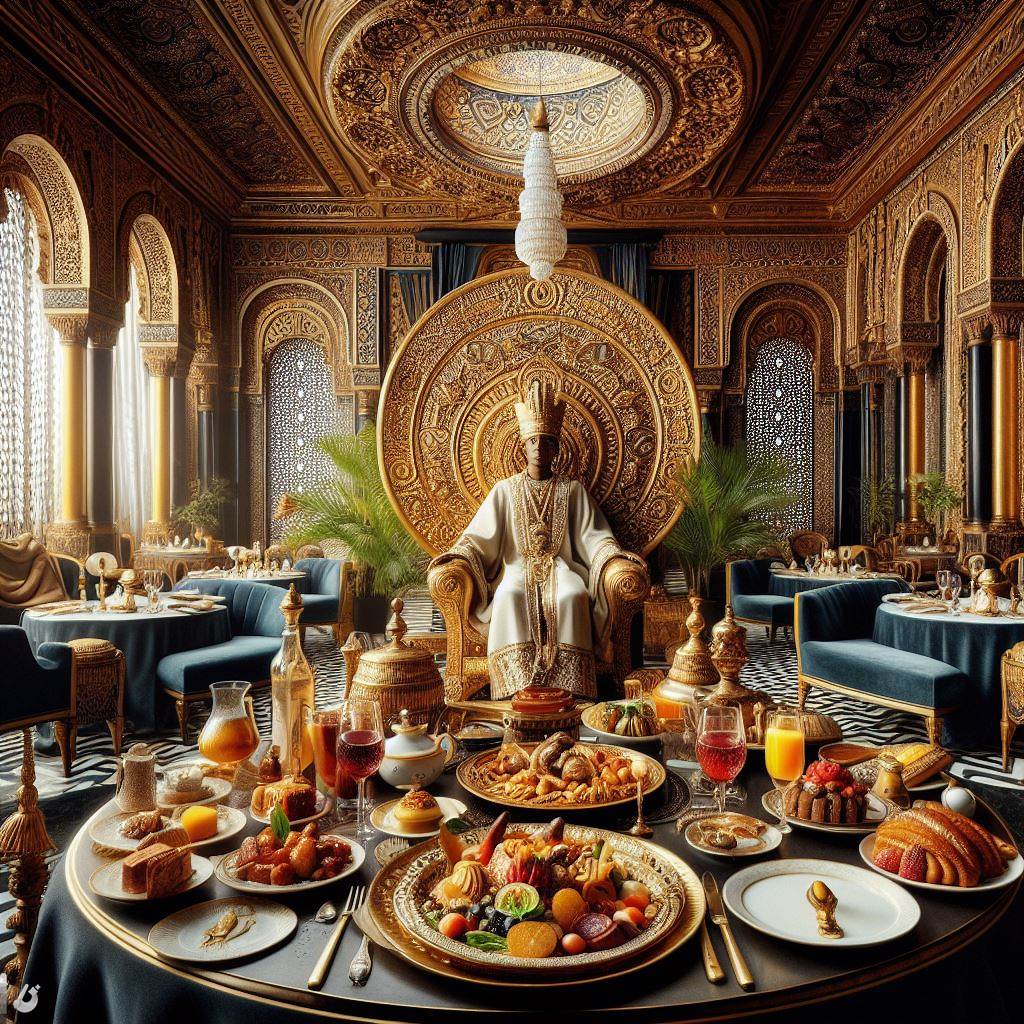A Journey Through Royal African Cuisine’s Opulent History and Signature Dishes
The Royal African Cuisine of ancient Africa was the center of extravagant flavors and grand cuisine that reflected divine power, status, and wealth. Years may have passed, but royal dishes still enchant us today by blending spices, luxuriously bold ingredients, and storied histories into regal recipes worth remembering.
Culinary Showpieces for the Powerful
Across Saharan trade routes to ports along the vast subnets of the Nile and savannas scattered across southern Africa, rulers of a bewildering patchwork of kingdoms governed the continent for millennia. Whether the legendary Mansa Musa of the 14th century Mali Empire was said to be the richest man to ever live or the line of God-like monarchs of the Ethiopian highlands tracing their lineage to biblical King Solomon and the Queen of Sheba, African leaders flaunted their authority and divine connections by hosting extravagant banquets and displays of conspicuous consumption.
Befitting a Divinely Blessed Monarch
From the majestic high-walled palaces of ancient Zimbabwe to the legendary House of Wisdom and towering libraries of Timbuktu, royal servants bearing ornately decorated gold platters proffered an eye-watering array of stately dishes. Among shaded courtyard gardens, rulers invited allies, courts, and foreign dignitaries to great halls perfumed by smoldering spice incense and tall brass braziers filled with simmering stews.
Whether sampled from fine Chinese porcelain or hammered brass plates cast by renowned Ife and Benin metal smiths, royal African dishes were edible declarations of distinction fit for a king (or queen).
The Global Influence of Trade Routes and Cultural Exchange
Royal African cuisine evolved through centuries of cultural influences shaped by migration and conquests. Camel caravans hauled goods from the prosperous Indian Ocean coastal city-states between Zanzibar and Mogadishu inland across the Sahara Desert to cities like Marrakech and Timbuktu. Through these well-trodden Saharan trade routes, African cooks gained access to new spices, ingredients, and cooking methods from the courts of Arabia, Persia, and the Indian subcontinent.
The slow spread of Islam across northern Africa and the Middle East from 600 AD onwards linked the kitchens of African royalty to Mediterranean flavors, grains, and savoir-faire. Following spice routes, couscous, wheat breads, vegetable tagines and honey-sweetened pastries feathered with rosewater or orange blossoms perfume became new courtly delicacies.
An Eclectic Blending of African and European Fusion Cuisine
The arrival of Portuguese explorers charting sub-Saharan Africa’s western coastlines in the late 1400s initiated another turbulent period of culinary exchange. African servants and cooks witnessed strange new vegetables, cooking tools, and seasonings like tomatoes, cassava, chili peppers, and ginger appearing aboard Portuguese cargo ships packed with looted eastern spices. Royal families coveted these exciting novelties as indicators of good fortune and divine blessing.
Guinea pepper, also called grains of paradise, was a particularly exotic status symbol, gracing the dishes of the wealthy Ashanti empire of West Africa to stimulate the senses like a gift from the heavens.
 |
Signature Characteristics of Royal African Cuisine
Complex Spice Blends
Rich spice blends electrify many iconic royal dishes, relying on cardamom, cinnamon, turmeric, nutmeg, chiles, paprika, and the heady native hibiscus leaf called Zobo in Nigeria. Balancing flavor contrasts like hot and cooling or sweet and savory was considered an edible way of representing the cosmic dualities central to many African creation mythologies.
The lush island of Zanzibar was once the world’s largest clove producer. Sultans of the Zanzibar Sultanate required court chefs to creatively utilize cloves and cinnamon in every dish possible to showcase their monopoly over the valuable trade goods in the Indian Ocean.
Showmanship Through Color and Presentation
In the Kingdom of Dahomey, located in modern-day Benin, elaborate ceremonial meals accompanied religious rituals and public festivals. Royal chefs dyed dishes vibrant colors using natural plant pigments and deliberately sculpted food into awe-inspiring animal shapes. One court dish called Kuli-Kuli was prepared by carefully frying groundnut paste into a golden snake or crocodile forms, believed to represent the mercurial vodun spirits and orisha gods governing the kingdom.
Another royal preparation called tô featured a pink millet or sorghum porridge tinted bright red to symbolize sacrifices made in war and formed into a pyramid shape representing the life-sustaining power of ancestors and community.
Showcasing Ingredients as Costly Offerings
In the wealthy savanna empire of Mali presided over by the legendary and pious Muslim ruler Mansa Musa from 1312-1337 CE, ingredients functioned as edible offerings. Cooks infused crumbled dried woods like sandalwood and oud with honey and then spooned them atop elaborate rice dishes called Jollof to signify rare imported treasures worthy of divine blessings.
Towering 5-foot java cake creations were another specialty dessert of Malian royal kitchens, calling for over a hundred eggs as the key ingredient. The countless fragile eggs conferred wishes for bountiful fertility and successful harvests in the year ahead.
Spotlight on Iconic Royal Recipes
Berbere-Spiced Doro Wat Chicken Stew (Ethiopia)
The intricately spiced national dish of Ethiopia called Doro Wat beautifully captures the unique fiery flavors of East African royal court cuisine. Tracing its origins back to the opulent kitchens of ancient queens and Coptic Christian Emperors ruling the Ethiopian highlands for three thousand years, Doro Wat blends smoky, slow-simmered chicken drumsticks or hard-boiled eggs with caramelized onions, red peppers, and intensely flavored berbere spice blend.
With notes of African bird’s eye chilies, ginger, basil, rue, garlic, and ajwain seeds rounding out over a dozen spices, Doro Wat embodies the lavishness of the Solomonic dynasty banquet tables through complex spicing regality. The stew is always served ceremoniously with a spongy sourdough flatbread called injera used to sop up the vibrant red sauce, made from an age-old royal Ethiopian grain called teff still favored today.
Mali’s Celebratory Jollof Rice Fit For a Mansa
The legendary 14th-century emperor of Mali called Mansa Musa astounded medieval Europe and the Middle East tales with over One thousand camels laden with gold, ambergris musk pods, and enslaved servants traveled alongside his massive pilgrimage caravan bound for Mecca in 1324 CE. As the richest ruler of his time, the exotic spices, rice dishes, and lavish feasts of Mali likewise dazzled foreign visitors.
One particularly showstopping preparation called Jollof combined imported rice from the lush river deltas of the Niger inland seas with hand-ground chilies, aromatic nutmeg, ginger, the prized Guinea grains of paradise, and fresh tomatoes. Royal servants likely used cone-shaped reed baskets imported from Morocco to steam the saffron-tinged rice into delectable perfection.
Spice Merchant’s Goat Meat Tagine of Northern Africa
In the wealthy North African port cities of Tunis, Algiers, and Tetouan, rulers presided over lucrative Mediterranean trade empires exporting sub-Saharan gold, metalwork, and slaves in exchange for European silver, shields, and horses. These bustling ports were also heaven for globe-trotting spice traders and merchants sailing between Morocco, Venice, Egypt, and Constantinople.
Elaborating on Persian and Turkish culinary influences of sweet and salty roasted lamb dishes, an iconic specialty called Tagine blends succulent cuts of meat with a sweet kick of dried apricots or stone fruits paired with warming cinnamon, turmeric, and ginger spices. Slow simmered in ornate glazed clay tagine pots, it’s easy to imagine this exceptional dish being served to wealthy merchants visiting the splendid tiles palaces of ancient rulers across North Africa.
The Enduring Allure of Royal Recipes
Despite the inexorable passage of centuries gradually eroding dynasties into faded history textbook entries, African royal cuisine remarkably continues to thrive today. Many iconic national dishes originated from various ancient palace kitchens, reinvented, and passed down from generation after generation. Author and James Beard award-winning Chef Pierre Thiam revives courtly recipes like jollof rice, berbere stews, and sumptuous grain dishes to reconnect modern diners to the sophistication of past royal African gastronomy.
So next time you take a bite of spice-flecked rice, succulent meat, or stew served with spongy injera pancakes, remember the ghosts of royal cooks past smiling in approval that ancient African flavors still entrance and satisfy us today.
References
1. “Kingdom of Mali.” Wikipedia, Wikimedia Foundation, 17 Jan. 2023, https://en.wikipedia.org/wiki/Mali_Empire
2. Thiam, Pierre. Senegal: Modern Senegalese Recipes from the Source to the Bowl. Lake Isle Press, 2015.
3. Wolfert, Paula. Mediterranean Clay Pot Cooking: Traditional and Modern Recipes to Savor and Share. John Wiley & Sons, 2009.


